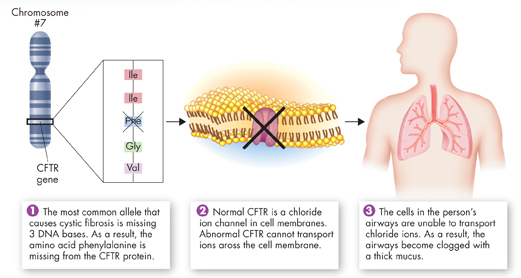
FIGURE 14–8 Mutations Cause Cystic Fibrosis CF is usually caused by the deletion of three bases in the DNA of a single gene. As a result, the body does not produce normal CFTR, a protein needed to transport chloride ions. Infer Why isn't the cause of CF considered a frameshift mutation?
d▸ Cystic Fibrosis Known as CF for short, cystic fibrosis is most common among people of European ancestry. CF is caused by a genetic change almost as small as the earwax allele. Most cases result from the deletion of just three bases in the gene for a protein called cystic fibrosis transmembrane conductance regulator (CFTR). CFTR normally allows chlo-ride ions (Cl−) to pass across cell membranes. The loss of these bases removes a single amino acid—phenylalanine—from CFTR, causing the protein to fold improperly. The misfolded protein is then destroyed. With cell membranes unable to transport chloride ions, tissues throughout the body malfunction.
People with one normal copy of the CF allele are unaffected by CF, because they can produce enough CFTR to allow their cells to work properly. Two copies of the defective allele are needed to produce the disorder, which means the CF allele is recessive. Children with CF have serious digestive problems and produce thick, heavy mucus that clogs their lungs and breathing passageways.
▸ Huntington's Disease Huntington's disease is caused by a dominant allele for a protein found in brain cells. The allele for this disease contains a long string of bases in which the codon CAG—coding for the amino acid glutamine—repeats over and over again, more than 40 times. Despite intensive study, the reason why these long strings of glutamine cause disease is still not clear. The symptoms of Huntington's disease, namely mental deterioration and uncontrollable movements, usually do not appear until middle age. The greater the number of codon repeats, the earlier the disease appears, and the more severe are its symptoms.
MYSTERY CLUE

Individuals with sickle cell disease have a different amino acid in one of their hemoglobin proteins than people without the disease. What could produce this change?
Table of Contents
- Formulas and Equations
- Applying Formulas and Equations
- Mean, Median, and Mode
- Estimation
- Using Measurements in Calculations
- Effects of Measurement Errors
- Accuracy
- Precision
- Comparing Accuracy and Precision
- Significant Figures
- Calculating With Significant Figures
- Scientific Notation
- Calculating With Scientific Notation
- Dimensional Analysis
- Applying Dimensional Analysis




